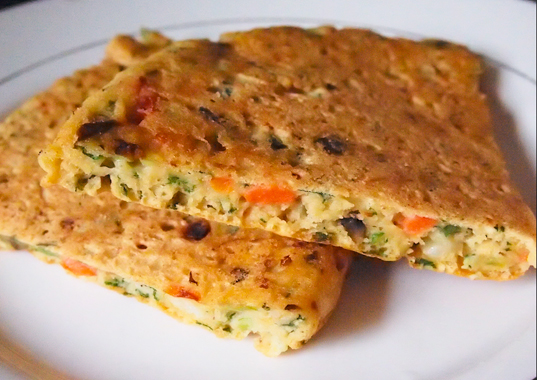Mama’s Punjabi Recipes: Gobi da Omelette (Cauliflower Omelette)
Phul gobi (cauliflower) – or simply gobi – is a favorite vegetable in the Punjabi kitchen as it is so versatile. It can be sautéed, fried in batter as pakoras, pickled in achaar or grated and cooked as a stuffing for paranthas or omelettes.
Cauliflower is a very beneficial vegetable, rich in calcium, magnesium, potassium and phosphorus as well as vitamin C. Interestingly, there are four major groups of cauliflower: the Italian, Northwest European biennial, Northern European annuals and Asian (which was developed in India in the 19th century) and hundreds of varieties.
There is only one secret to making gobi that is firm, not mushy, and still is loaded with the flavor of spices and has that slight nutty taste, and that is to let it cook in its own steam and not to add any water.
Many desi restaurants take the easy way out and cook frozen florets of cauliflower with other frozen vegetables with a little sauce, but that really does not do justice to gobi. Delicious gobi ki sabzi must be soft but firm, and especially not watery and adding potatoes or other vegetables only adds mass to the sabzi, not more the taste.
You can get the same great taste, enhanced with the wholeness of pan-roasted wheat flour, when cooking the grated gobi in paranthas which are always a big hit. And in case you don’t want to go to the trouble of making dough, a gobi omelette is much easier to make and gives the same satisfying taste.
Ingredients:
1 cup grated phul gobi (grated cauliflower)
4 badde ande (large eggs) – makes two omelettes
4 cup tael (olive oil or vegetable oil)
¼ tsp sarson til (mustard seeds)
Spices (to taste): namak (salt), mirch (red pepper).
Directions:
1. Remove the outer stalks of the gobi and then cut off the florets. Wipe them clean with a damp cloth. If you wash them, you must let them dry completely as gobi doesn’t need extra water to cook.
2. Take the dry florets and run them over a large hole grater so that it some out in medium-large crumbs.
3. Heat the oil in a karai or wok over medium. Throw in the mustard seed and let it roast for 30 seconds.
4. Now add in the salt and pepper, stir and add the grated gobi. Mix well and cover over medium high heat for 3 or 4 minutes. Do not open the cover as the gobi will cook in its own steam, stirring gently occasionally to make sure it does not stick or start to burn.
5. Check to see the gobi is cooked and slightly brown, and when the water is dried out, then turn the heat off, take the cover off and let it cool down.
6. This recipe if for two omelettes. Beat the eggs well in a bowl and then pour half of the mixture into a heated skillet over low heat. Spread the mixture around and when the sides are cooked, scoop in half of the cooked gobi onto a half side.
7. When the batter looks semi-cooked, fold the other half over and press down on the gobi to flatten it.
8. Flip the omelette over with a spatula and let the other side cook. Take off and serve in a plate. Use the remaining ingredients to cook the other omelette.
MAMA’S TIP OF THE WEEK
GET THE FULL FLAVOR WHEN MAKING GOBI
To get the full flavor and nutty taste of gobi, there are some basic things to remember so that you don’t get a soggy, mushy mess. Make sure that the gobi is dry: if you peel and cut it, then it is better to wipe it with a damp cloth. If you wash it, let it dry off completely as it should cook in its own steam and you do not have to add any water. Also, be careful not to add too much haldi (turmeric) as it will make the dish bitter. And finally, do not add onions to the gobi as they make the dish sweet: you may add some adrak (ginger) but definitely no amchoor (green mango powder).

Shakuntla Malhotra is a skilled cook of Punjabi dishes made in the old-fashioned style that she learnt as a young woman in her ancestral home in Lyallpur (since renamed Faisalabad), India before it became part of Pakistan after the Partition in 1947. People have often admired her cooking for its simplicity and taste that comes with each mouthful. Even in her mid-eighties, she continues to cook daily and agreed to share some of her delectable Punjabi recipes.

